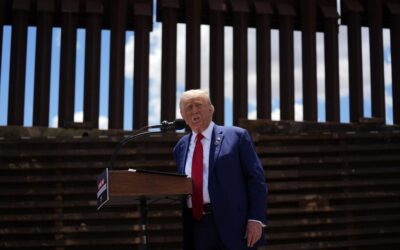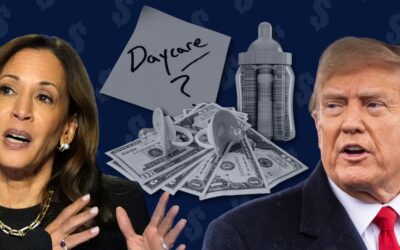
#image_title
Kleefisch says Evers’ “leadership stinks” but acknowledges small businesses are recovering “far faster than we ever could have hoped.”
Former Lt. Gov. and current Republican gubernatorial candidate Rebecca Kleefisch—in the midst of a recent campaign speech in Black River Falls about how much Gov. “Tony Evers’ leadership stinks”—said that “small businesses in Wisconsin are awesome and resilient and began to recover far faster than we ever could have hoped.”
But she did not say why she thought they were recovering well, nor acknowledge they are doing it under Evers.
While Wisconsin small businesses are objectively awesome, a big part of their recovery comes from the COVID relief and economic stimulus implemented by the federal government and Evers, said Shawn Phetteplace, regional midwest manager for the Main Street Alliance, progressive small-business advocacy organization.
Phetteplace said one of the biggest challenges small businesses face is access to funds, and Evers has channeled a lot of COVID-19 relief funds toward small businesses.
“The Evers administration has done more for small business than probably about any other state government in the country on a per capita basis to help provide grants and direct support,” Phetteplace said, “which is really what small businesses needed most this year.”
RELATED: ‘Tethers to These Communities’: Wisconsin Shows Up for Small Business Saturday
Evers put more than $500 million of federal COVID-19 funds into small business grant funds, such as the Wisconsin Tomorrow Small Business Recovery grant program, Equitable Recovery program, and the Diverse Business Investment program.
“Thousands of small businesses have benefited from the governor’s common-sense leadership,” a spokesperson for Evers’ re-election campaign told UpNorthNews. “Gov. Evers believes in Wisconsin small businesses and has empowered them to expand, create jobs, and grow economic opportunity in communities across the state.”
Kleefisch’s campaign did not respond to a request for comment.
“Back to Work”
Kleefisch also blamed Evers for the worker shortage because he allowed federal unemployment (UI) benefits to continue until the program expired. In the early days of the pandemic, unemployed workers received an additional $600 per week from the first federal COVID relief bill to help people make it through the mass layoffs that coincided with the pandemic’s arrival. That number subsequently dropped to an additional $300 per week, which expired in September.
“[Businesses] are not even finding the labor force that they need,” Kleefisch said. “Tony Evers was literally one of the last governors in America to just hold on to that federal booster payment on top of unemployment insurance, so that he was literally paying people more to sit on the sidelines, as opposed to get back in the economy and back to work.”
Analysis of the 26 states that ended the benefits early show it had little effect on unemployment rates. Furthermore, those payments helped sustain consumer spending, keeping the economy—and businesses—afloat.
During the debate over the UI benefits, a report from Urban Milwaukee showed Wisconsin’s worker shortage is structural. Wisconsin’s working-age population peaked in 2011, and Wisconsin Policy Forum researchers were sounding the alarm about a “pending storm” unless the state managed to attract new, younger workers to replace its aging workforce.
Kleefisch acknowledged as much in her Black River Falls speech, but didn’t acknowledge how much she and her former boss, former Gov. Scott Walker, are at fault for the current situation.
“We also need to prioritize our labor force, because we need workers in Wisconsin,” Kleefisch said. “We need to put trades and vocational education in every K-12 school district across this great state and we need to double the number of youth apprentices in Wisconsin.”
During Kleefisch’s tenure as lieutenant governor, former Gov. Scott Walker cut the state’s education budget by $1.1 billion, including $71.6 million—around 30%—for technical colleges, resulting in a 4.6% tuition increase. And while Walker froze in-state tuition, the funding cuts meant students weren’t able to access scholarships and had to pay half their tuition, as opposed to 40% when Walker took office.
All told, a decade of cuts and diversions led to Wisconsin schools losing out on about $4 billion.
Those policies could have an outsized impact on people looking to move to Wisconsin: Strong schools are important to 73% of homebuyers when making their relocation choices, according to a 2018 Realtor.com survey. “We need to get back to work,” Kleefisch added.
What she’s missing is, we already have.
UW-Milwaukee professor John Heywood told UpNorthNews last month that Wisconsin has, for a long time, had an “above-average labor force participation rate,” meaning that Wisconsinites who are able to work, do. And as the Republican National Committee’s research Twitter account tweeted, Wisconsin’s 3% unemployment rate is the 11th-lowest in the nation.

Medical debt will no longer appear on credit reports for all Americans
This new rule will erase an estimated $49 billion in unpaid medical bills from the credit reports of roughly 15 million Americans, according to the...

Sick of hidden fees on concert tickets and hotel stays? A new federal rule bans them.
Now, live event businesses and hotels must clearly list their prices in both their advertising and pricing information. American consumers on...

Trump’s tariff plan would raise prices and ‘reduce the living standard of Americans,’ economists say
Trump’s plan would effectively be a sales tax that disproportionately harms working-class families and could cause a trade war that hurts US...

Trump’s tariff and tax plan would raise taxes on 95% of Americans, report finds
In response to the report, the Harris-Walz campaign released an analysis of its own, outlining how Trump’s agenda would raise costs for nearly 2.5...




